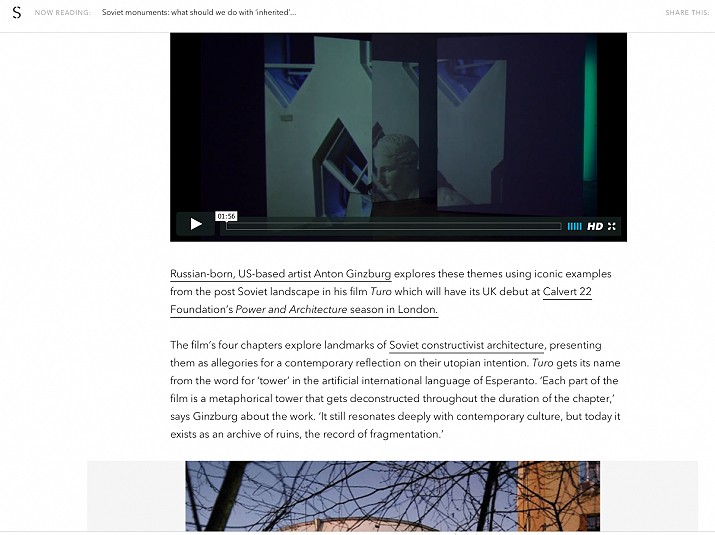Soviet monuments: what should we do with ‘inherited’ architecture?
Calvert 22 Foundation curator Will Strong on wrestling buildings from their political pasts.
by Will Strong
http://thespaces.com/2016/07/06/soviet-monuments-inherited-architecture/
Russian-born, US-based artist Anton Ginzburg explores these themes using iconic examples from the post Soviet landscape in his film Turo which will have its UK debut at Calvert 22 Foundation’s Power and Architecture season in London.The film’s four chapters explore landmarks of Soviet constructivist architecture, presenting them as allegories for a contemporary reflection on their utopian intention. Turo gets its name from the word for ‘tower’ in the artificial international language of Esperanto. ‘Each part of the film is a metaphorical tower that gets deconstructed throughout the duration of the chapter,’ says Ginzburg about the work. ‘It still resonates deeply with contemporary culture, but today it exists as an archive of ruins, the record of fragmentation.’We are guided through Melnikov House, the Narkomfin Building, ZIL (an automobile factory designed by Vesnin brothers, now demolished) and the Monument to the Third International, designed by Vladimir Tatlin but never realised. Ginzburg places the iconic unbuilt structure in the ‘ghost mode’ of a video game, siting this tower in the Ukrainian town of Pripyat, famously decimated in the wake of the Chernobyl disaster. In Turo, Ginzburg is able to explore the cultural legacy of these real and imagined spaces, from the stage of their own dilapidation.Each of the four towers stood once as lofty pillars of high modernity, signifiers of an optimistic wave of the Constructivist avant-garde. This is now the vantage point of their critique. Two of the three buildings from the film have at least survived the drastic changes in Moscow following the collapse of the union.
Today they stand away from centre stage, as monuments to the utopian ambitions of the movement. With numerous reports of planning activity from the city, it is clear that these towers share an awkward relationship with the future that they were designed for.


